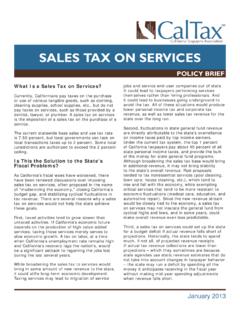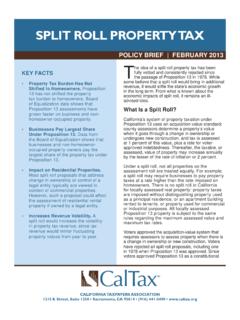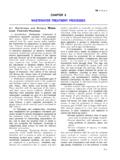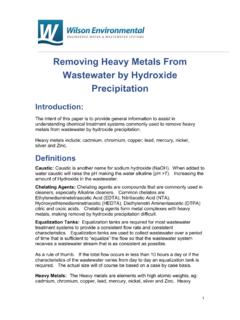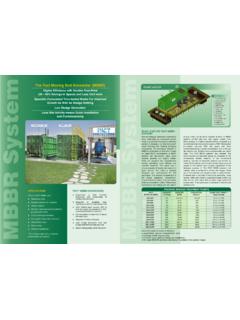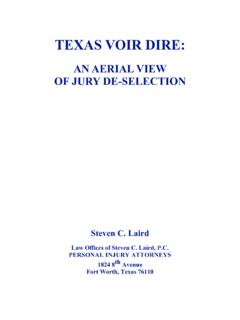Transcription of Split Roll Factsheet - California Taxpayers Association
1 California Taxpayers ASSOCIATION1215 K Street, Suite 1250 Sacramento, CA 95814 (916) 441-0490 roll PROPERTY TAXPOLICY BRIEF | FEBRUARY 2013 The idea of a Split roll property tax has been fully vetted and consistently rejected since the passage of Proposition 13 in 1978. While some believe that a Split roll would bring in additional revenue, it would stifl e the state s economic growth in the long term. From what is known about the economic impacts of Split roll , it remains an ill-advised Is a Split roll ? California s system of property taxation under Proposition 13 uses an acquisition-value standard: county assessors determine a property s value when it goes through a change in ownership or undergoes new construction, and tax is assessed at 1 percent of this value, plus a rate for voter-approved indebtedness. Thereafter, the taxable, or assessed, value of property may increase annually by the lesser of the rate of infl ation or 2 a Split roll , not all properties on the assessment roll are treated equally.
2 For example, a Split roll may require businesses to pay property taxes at a rate higher than the rate imposed on homeowners. There is no Split roll in California for locally assessed real property: property taxes are imposed without distinguishing property used as a principal residence, or an apartment building rented to tenants, or property used for commercial or industrial purposes. All locally assessed Proposition 13 property is subject to the same rules regarding the maximum assessed value and maximum tax approved the acquisition-value system that requires assessors to assess property when there is a change in ownership or new construction. Voters have rejected all Split roll proposals, including one in 1978 when Proposition 13 was approved. Since voters approved Proposition 13 as a constitutional KEY FACTSP roperty Tax Burden Has Not Shifted to Homeowners. Proposition 13 has not shifted the property tax burden to homeowners. Board of Equalization data shows that Proposition 13 assessments have grown faster on business and non-homeowner-occupied Pay Largest Share Under Proposition 13.
3 Data from the Board of Equalization shows that businesses and non-homeowner-occupied property owners pay the largest share of the property tax under Proposition 13. Impact on Residential Properties. Most Split roll proposals that address change in ownership or control of a legal entity typically are viewed in context of commercial properties. However, such a proposal could affect the assessment of residential rental property if owned by a legal entity. Increases Revenue Volatility. A Split roll would increase the volatility in property tax revenue, since tax revenue would mirror fluctuating property values from year to year. 2 POLICY BRIEF amendment, any changes to Proposition 13 require a vote of the Shift in Tax Burden?Contrary to what supporters of Split roll claim, Proposition 13 does not shift the property tax burden to homeowners. The assessed value of non-homeowner property subject to Proposition 13 has grown an average of percent per year, while homeowners property tax has grown an average of percent.
4 Thus, the Proposition 13 property taxes paid by non-homeowners have outpaced homeowners property tax burden. In fact, Proposition 13 has prevented a property tax shift to Is the Economic Impact on California ?During the past three decades, there have been numerous Split roll proposals to replace California s current single- or unifi ed- roll tax system for locally assessed real property. The current system has had a positive economic effect, and while the details of Split roll proposals differ, they have a common feature: if a Split roll system is enacted, a large share of California property no longer would be protected by the limitations on property tax assessments established by voters when they approved Proposition 13, creating a signifi cant economic threat to for the Economy and Consumers. The Legislative Analyst s Office found that a Split roll would increase costs to businesses due to higher property taxes, which could result in higher product prices, reduction in employees salaries, and a reduction in overall economic activity.
5 Higher prices on products and services would make California businesses less competitive in national and global Dwelling Units Will Be Negatively Impacted by a Split roll . Proponents argue that a Split roll would generate more revenue without directly taxing a large bloc of voters who own houses. This is based on the principle, Don t tax you, don t tax thee, tax that fellow behind the tree. Unfortunately for Split roll proponents, no matter how a Split roll is drafted, there will be some or many dwelling units on the wrong side of the Split . All Split roll proposals to date suffer from Source: Board of and Non-Homeowner Real Property Subject to Proposition 13, Real Property, 1979-80 to 2011-12, the average annual growth of assessed value for business and non-homeowner real property subject to Proposition 13 has outpaced the growth of homeowner-occupied property. AVERAGE ANNUAL GROWTH OF ASSESSED VALUES OF PROPERTY SUBJECT TO PROPOSITION 13 Split roll PROPERTY TAX 3this infi rmity.
6 Voters should be aware that a Split roll tax may increase tax burdens on their dwelling Many Businesses. A Split roll would adversely impact businesses, particularly small businesses, because their lease costs would increase with higher property taxes. Lease payments on commercial buildings, shopping centers and business parks would increase to reflect increased property taxes, as most commercial leases allow for such increases. Smaller businesses would be less able to absorb a sudden rent increase due to reassessment, and many would have to reduce their number of employees or close down Retirees. Retirees whose pension funds invest in California businesses and business properties would see the value of their funds reduced, as these businesses become less competitive and less profitable. For example, as of October 2012, the California Public Employees Retirement System (CalPERS) had $ billion invested in California real assets, including real estate and other property holdings.
7 Since the effects of the higher property taxes brought about by a Split roll would be capitalized, the market price of these real estate holdings would decrease. The market value of CalPERS California equity holdings also would go down if the issuing corporations and other legal entities were not able TAX BURDEN FOR PROPERTIES UNDER PROPOSITION 13 Source: Board of ASSESSMENT PERIOD2011-12 ASSESSMENT PERIODB usiness and Non-Homeowner Property Subject to Proposition 13, Property, and Non-Homeowner Property Subject to Proposition 13, Property, from the Board of Equalization shows that the property tax burden has not shifted to homeowners. In fact, a small shift toward business and non-homeowner property subject to Proposition 13 has occurred. Homeowner-occupied properties are residential properties serving as a principal place of residence, where owners claim the homeowners exemption. Business and non-homeowner property includes commercial and industrial property, and other investor-owned property subject to Proposition 13.
8 Founded in 1926, the California Taxpayers Association is the state s oldest and largest organization representing Taxpayers . Established as a nonpartisan, nonprofi t research and advocacy Association , CalTax has a dual mission to guard against unnecessary taxation and to promote government effi ciency. Visit for research, data, analysis and commentary on California tax issues. California Taxpayers Association1215 K Street, Suite 1250 Sacramento, California 95814 Phone: Our 2013 California Taxpayers Association . All Rights CalTax4 POLICY BRIEFto pass along the increased tax burden to renters, employees and consumersIs a Split roll the Solution to the California s Fiscal Problems?As California s fi scal woes have worsened, there has been renewed discussion about establishing a Split roll system, often in the name of closing a corporate loophole and funding vital local services, including ranks substantially higher in aggregate tax burden than the Western states with which we compete for jobs and investments.
9 Raising taxes is not the solution to the state s fi scal problems. Leads to Unfair and Subjective Tax Policy. Prior to Proposition 13, assessors used the theory of "highest and best use," which meant that property value was estimated by considering the "highest and best use" of the property, rather than the actual use. This forced many property owners to sell their property. A return to market-value assessments would bring back this undesirable assessment method, which was partly responsible for the property tax revolt that led to enactment of Proposition 13. It also was a key element in the assessors scandals in the 1960s. Moreover, a return to assessments based on market value would shift taxes from an objective standard (sales price) to a subjective one (assessors' opinion of value), leading to arbitrary assessments and more Revenue Volatility. A Split roll based on the market value of real property would increase volatility in property tax revenue, as revenue would be directly impacted by the fluctuation of property values from year to year.
10 Proposition 13 stabilized the flow of property tax revenue by locking in acquisition values, and allowing these values to increase slowly from year to year. If taxes on locally assessed real property were based on market values, local government would not be able to absorb the enormity of the losses during downturns for example, locally assessed real property values fell $86 billion during the 2009-10 fiscal year, and $76 billion during the 2010-11 fiscal year. One of the unheralded benefits of Proposition 13 is that it serves as a circuit breaker to large fluctuations in market values, either upward or Obstacles. A Split roll based on sales of stock is administratively unworkable. Stock of a publicly traded company changes hands numerous times each hour, day, month and year. How would such a company determine the cumulative effect of changes in stock ownership? Assessors would have to revalue property each time a change occurred, resulting in hundreds, if not thousands, of reappraisals each year for a single company.


